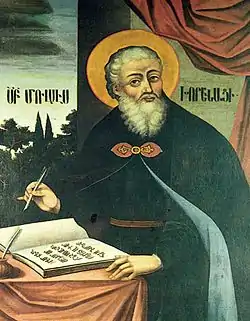Stephen Orbelian
Stepanos Orbelian (Armenian: Ստեփանոս Օրբելյան; c. 1250-1260 – 1303) was a thirteenth-century Armenian historian[1] and the Metropolitan bishop of the province of Syunik. He is known for writing his well-researched History of the Province of Syunik.
Stepanos Orbelian | |
|---|---|
| Born | c. 1250-1260 |
| Died | 1303 (aged 43-53) |
| Resting place | Noravank |
| Occupation | Metropolitan bishop, historian |
| Known for | History of the Province of Syunik |
Biography
Orbelian was a member of the Orbelian family of princes and feudal lords who ruled Armenia's province of Syunik. He received his education at a religious seminary, and in 1285 his father, Tarsayich Orbelian, sent him to Cilician Armenia, where he was consecrated a metropolitan bishop on Easter 1286.[2] He remained there for three months as a guest of King Levon III and finally returned to Syunik in 1287.[3] Orbelian died in 1303 and was buried in the family mausoleum in the monastery complex at Noravank.
Works
Orbelian is known to have completed three works during his lifetime: the History of the Province of Syunik (Patmut'yun Nahangin Sisakan), in 1297; the Lament on Behalf of the Cathedral (Voghb i dimats' surb Kat'oghikeyin), where he calls on the Armenians to repopulate historic Armenia, which was at the time under foreign control, in 1300; and the Argument Against Dyophysitism (Hakacharut'iun unndem yerkabnakats'), in 1302, a work criticizing the pro-Byzantine and Westernizing tendencies of Grigor VII Anavarzetsi of Cilicia.[4]
Of the three, the most prominent is that on the history of Syunik and the Orbelian family.[2] Before he began writing it, he conducted an extensive amount of research, utilizing a wide variety of sources derived from speeches, letters, colophons, previous histories and chronicles by Armenian historians, as well as works by Georgian authors.[2][5] Like other Armenian historians and chroniclers, Orbelian's work briefly narrates the beginning of the world starting with Adam and Eve, but then moves on to tell Syunik's and Armenia's history, spanning from the time of king Tiridates I to the end of the thirteenth century. Orbelian's work is especially valuable as it contains many previously unknown details about the province and Armenian history.[2] In 1864 and 1866, History was translated into French by orientalist Marie-Félicité Brosset and in 2020 into Russian by Margarita Darbinian.[6] Some excerpts were also translated Georgian.[2]
Notes
- Armenia and Iran. v. Accounts of Iran in Armenian sources — Encyclopædia Iranica. M. Van Esbroeck"This list of ten Armenian historians is obviously not exhaustive. Other important writers include Yovhannēs Drasxanakertecʿi (d. 931), who left a History of Armenia arguing ecclesiastical legitimacy from the anti-Chalcedonian point of view. He alone tells of the great fire temple erected in Duin under Yazdegerd II before the moving of the Armenian episcopate to this town in the 460s. Such historians as Ṭʿouma Arcruni in the 10th century, Stepʿanos Asołik in the 11th, Aristakēs Lastivertcʿi between 989 and 1071, and Matṭʿeos Urhayecʿi between 952 and 1136 still draw occasionally on ancient historians, some of whose data they reproduce. It is in general only because of this tendency that they are of interest in connection with Iranian material. The histories of Stepʿanos Orbelian and Stepʿanos Siwnecʿi, written between 1307 and 1322, contain numerous semi-legendary data on the origins of Siwnikʿ. They are a last echo of a historical method whose first impetus had been given by Movsēs Xorenacʿi and Agathangelos."
- (in Armenian) Torosyan, K. «Ստեպանոս Օրբելյան» [Stepanos Orbelian] Armenian Soviet Encyclopedia.Yerevan: Armenian Academy of Sciences, 1985, vol. 11, pp. 139-140.
- Hacikyan, Agop Jack; Gabriel Basmajian; Edward S. Franchuk (2002). Agop Jack Hacikyan (dir.), The Heritage of Armenian Literature, vol. II : From the Sixth to the Eighteenth Century. Detroit: Wayne State University. p. 534. ISBN 0-8143-3023-1.
- See S. Peter Cowe, "Catholicos Grigor VII Anavarzetsi and Stepanos Orbelian, Metropolitan of Siunik, in Dialogue" in Armenian Cilicia, eds. Richard G. Hovannisian and Simon Payaslian. UCLA Armenian History and Culture Series: Historic Armenian Cities and Provinces, 7. Costa Mesa, California: Mazda Publishers, 2008, pp. 245-260.
- Hacikyan et al. The Heritage of Armenian Literature, p. 535.
- Histoire de la Siounie, Saint Petersburg, 1864, accessed 2012-03-06․ Степанос Орбелян, История дома Сисакан, Ереван, 2020,
